Spatial and temporal changes in small-strain shear modulus of geogrid-stabilized crushed aggregate materials
IF 4.9
2区 工程技术
Q1 ENGINEERING, CIVIL
引用次数: 0
Abstract
Geogrid stabilization can be used by transportation agencies to build durable roadways over soft subgrade soil. The performance of geogrid stabilization is highly dependent on the properties of the geogrid material, the aggregate material, and the interaction between the two materials when combined. Therefore, transportation agencies need to perform their own studies to assess the performance of geogrid stabilization for their local materials. Additionally, the current knowledge base needs to be continually expanded to a variety of aggregate-geosynthetic composites to develop performance-based design methods for geosynthetic-stabilization. This study evaluates the long-term performance of two geogrids used to stabilize a crushed aggregate material. A full-scale traffic loading system was built to simulate a full half-axle (40kN) traffic load for thousands of load cycles. Two trials were completed using the same crushed aggregate material. For each trial, two geogrid-stabilized sections, and one control section were evaluated. The performance of the test sections was monitored for 4000 load cycles by measuring surface rutting and completing multichannel analysis of surface waves (MASW) to measure aggregate stiffness. Results showed that the geogrid-stabilized sections had better long-term performance than the control sections with lower degradation of the as-built aggregate stiffness. There was good agreement amongst the MASW results, rutting measurements, and Shakedown analysis. It has been concluded that MASW is an effective method for evaluating the long-term performance of geogrid stabilization in aggregate layers with a customized instrumentation plan according to the targeted measurements.
求助全文
约1分钟内获得全文
求助全文
来源期刊

Transportation Geotechnics
Social Sciences-Transportation
CiteScore
8.10
自引率
11.30%
发文量
194
审稿时长
51 days
期刊介绍:
Transportation Geotechnics is a journal dedicated to publishing high-quality, theoretical, and applied papers that cover all facets of geotechnics for transportation infrastructure such as roads, highways, railways, underground railways, airfields, and waterways. The journal places a special emphasis on case studies that present original work relevant to the sustainable construction of transportation infrastructure. The scope of topics it addresses includes the geotechnical properties of geomaterials for sustainable and rational design and construction, the behavior of compacted and stabilized geomaterials, the use of geosynthetics and reinforcement in constructed layers and interlayers, ground improvement and slope stability for transportation infrastructures, compaction technology and management, maintenance technology, the impact of climate, embankments for highways and high-speed trains, transition zones, dredging, underwater geotechnics for infrastructure purposes, and the modeling of multi-layered structures and supporting ground under dynamic and repeated loads.
 求助内容:
求助内容: 应助结果提醒方式:
应助结果提醒方式:


